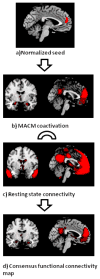Definition and characterization of an extended social-affective default network
- PMID: 24399179
- PMCID: PMC4087104
- DOI: 10.1007/s00429-013-0698-0
Definition and characterization of an extended social-affective default network
Abstract
Recent evidence suggests considerable overlap between the default mode network (DMN) and regions involved in social, affective and introspective processes. We considered these overlapping regions as the social-affective part of the DMN. In this study, we established a robust mapping of the underlying brain network formed by these regions and those strongly connected to them (the extended social-affective default network). We first seeded meta-analytic connectivity modeling and resting-state analyses in the meta-analytically defined DMN regions that showed statistical overlap with regions associated with social and affective processing. Consensus connectivity of each seed was subsequently delineated by a conjunction across both connectivity analyses. We then functionally characterized the ensuing regions and performed several cluster analyses. Among the identified regions, the amygdala/hippocampus formed a cluster associated with emotional processes and memory functions. The ventral striatum, anterior cingulum, subgenual cingulum and ventromedial prefrontal cortex formed a heterogeneous subgroup associated with motivation, reward and cognitive modulation of affect. Posterior cingulum/precuneus and dorsomedial prefrontal cortex were associated with mentalizing, self-reference and autobiographic information. The cluster formed by the temporo-parietal junction and anterior middle temporal sulcus/gyrus was associated with language and social cognition. Taken together, the current work highlights a robustly interconnected network that may be central to introspective, socio-affective, that is, self- and other-related mental processes.
Conflict of interest statement
The authors declare no conflict of interest.
Figures






References
-
- Adolphs R, Cahill L, Schul R, Babinsky R. Impaired declarative memory for emotional material following bilateral amygdala damage in humans. Learn Mem. 1997;4(3):291–300. - PubMed
-
- Allman JM, Hakeem A, Erwin JM, Nimchinsky E, Hof P. The anterior cingulate cortex. The evolution of an interface between emotion and cognition. Ann N Y Acad Sci. 2001;935:107–117. - PubMed
Publication types
MeSH terms
Grants and funding
LinkOut - more resources
Full Text Sources
Other Literature Sources

